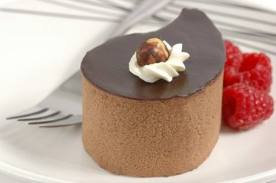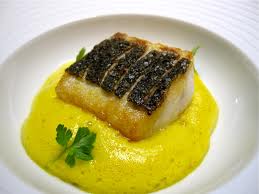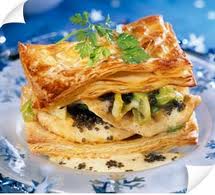|
[?]Subscribe To This Site
|
Deciphering the French Menu
Here are a few tips to unravel the fancy French menu terminology which trips up even the most sophisticated diner out-er. This will come in handy for English speakers worldwide because these pearls of verbiage have weaselled their way onto the non-photographic menus of a selection of upper price range establishments not located in France.
French TermsA French adjective thrown in here and there seems to justify a pricey dish. I’m certain you’ve already mastered a few of these elusive words without a blink of the eye.
SautéedHow about sautéed? This word comes from the verb sauter which means “to jump”, and refers to a cooking technique involving jumping beans. No, a bit of a leg pull there. It does, however, describe a frying pan with veggies or bits of meat which are cooking on high with little or no fat to keep them from sticking and lots of adept flipping. I know I’ll have to clean the stovetop after I sauté anything. It’s the adept part I haven’t quite mastered. Some of it invariably ends up sauté on the floor.
Au JusAnother term from a French menu that you might know is au jus. Recently I was in the UK, watching TV in my hotel room and zapped onto a wonderful program involving celebrities and their pet peeves in restaurants. One chap who I won’t identify, groaned about the au jus word. He couldn’t pronounce it and was disgusted that the menu didn’t just say “swimming in gravy”. I have to disagree with “he-who-won’t-be-named”. Voldemort should know that au jus means “dressed with the juices released during cooking”, which are by no means “gravy”. Gravy is a substance most often reconstituted from a packet of freeze-dried granules of unidentifiable chemicals dissolved with warm water: sorcery gone wrong. Although my Grandma, bless her soul, knew how to do the real thing. It was for special occasions: Sunday dinners and such. Weekday potatoes only earned a pat of butter. Au jus is easy. Cook your meat, drizzle it with the drippings. Voilà! Au jus! Do note that this term refers exclusively to meat. You never serve boiled potatoes drizzled with the water they’ve been boiled in.
MousseYou’ll know yet another word… mousse. Lately it’s been appearing in hair care products or make-up. I prefer the chocolate version, in a bowl, served with a cat’s tongue. Those are cookies by the way, not kitty taste appendages. You dip your oblong crispy cookie into the mousse and nibble it. This is an unsophisticated dessert, available on kid’s menus throughout France.
If you really want to be extravagant, serve it with chilled champagne and your guests won’t go home until both are gone. Today, new types of mousse are made of other things than chocolate. I recently ate one whipped up from green peas. A bit odd that, though peas are actually kind of sweet and it wasn’t served as a dessert. It was, however, green.
Emulsion
That’s kind of a mousse really except that the contents have been whipped up into a foamy state: kind of like how you feel when you’re late for work, your hair is bad and your ring catches in your stockings when you’re ready to leave the loo just before an important meeting with your new boss. Whipping things into a frenzy before serving them isn’t always a good thing. Sometimes they fall flat before they reach the mouth and the result is disappointing. This principle applies to various things in life and personally, I find it to be deceiving. Carrots are carrots and shouldn’t be emulsified, sautéed yes, emulsified, probably not.
Feuilleté
In French, feuille means leaf, thus a flaky pastry. A millefeuille is a thousand leaf pastry, or layers of anything. I know a chef who uses millefeuille on a French menu to describe a pile of various vegetables layered into the leaning tower of Pisa, with no pastry at all: just veggies.
And now English to French.... Snack!I recently ran across the opposite situation where ambitious chefs from France adopted an American word in the most inconceivably odd way. If you’ve ever worked in a restaurant, you’ll know of a flat stainless steel cooking surface which is often named “the grill”. It doesn’t have slats like your grill at home on the barbecue does. This is the flat, scrubbable surface on which hamburgers sizzle. So, have a seat because I’m about to reveal something pretty shocking…it has become sophisticated for a French chef to describe slapping some meat or fish onto the heated stainless steel plate with no oil, butter or other fat and flipping it once as snacking on a French menu. This is because they call a fast food restaurant a snack. They’ve actually made up a verb belonging to the first group of “er” verbs. The Frenchified version looks like this: snacker and its past participle is snacké. So, you may see Coquilles Saint Jacques juste snackés on a posh French menu. I almost fell off my chair when it first came to my attention. That the French would adopt the words for “weekend” and “lol” are one thing, but to assimilate the burger flipping of a snack is weird beyond belief. Go figure.
Have You Seen Any Unknown Terms on a French Menu?If you have run across any odd words displayed on a menu that you’d like clarification for, please ask about it here and I’ll be happy to answer your questions. Return to France Vacations Made Easy Home Page |
|




 How about emulsion?
How about emulsion?  Feuilleté is a type of pastry crust. It appears mostly in savory dishes, like meat pie types of things.
Feuilleté is a type of pastry crust. It appears mostly in savory dishes, like meat pie types of things. 